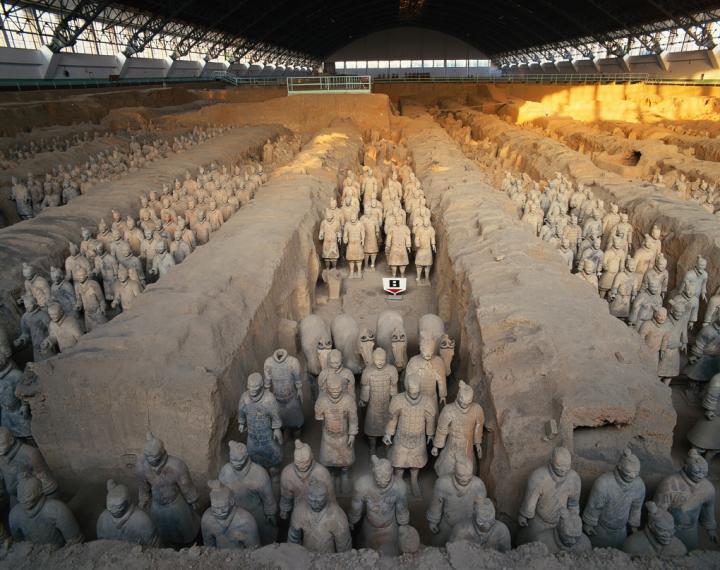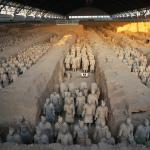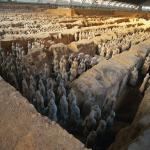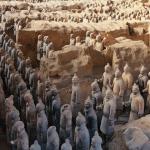Xi’an: Where China Became a Nation
I was watching on television in Toronto when, as a part of the 2003 Silk Road Festival being held in Aleppo Syria, a scene was being re-enacted of caravans arriving, after a long journey, from China. "It must have commenced its journey in Xi'an", I thought to myself. I had read much about that historic Chinese city and had always yearned to explore its historic sites.
Now, a few months later, I was walking the streets of that imperial Chinese metropolis which has become for visitors China's exotic mecca. Its many attributes, especially its historic remains, have made it a much sought tourist destination.
Standing above all its appeals is its Terra Cotta army, ancient and well-preserved medieval walls - one of few walled cities that still exist in China - the atmosphere of its Muslim quarter and an excellent well-known cuisine. As I explored its historic sites, examined the handiwork of its artisans and sampled its savory foods, I felt that my dream had come true. Historic Xi'an, with a long and illustrious history, was within my grasp.
Situated strategically at the crossroads of the routes crossing China and Central Asia, the city, during the Classical period and the Middle Ages, grew into one of the most sophisticated and wealthiest urban centres in the world. At the height of its splendour, it vied with Rome and later with Constantinople and Cordova as the greatest city on the globe.
In those centuries, it was also the first Chinese city to open its doors to the outside world. It established itself as a world leader in culture and trade and became the first stop on the famous Silk Road, playing a vital role in bridging the gap between East and West.
With a history going back some 3,000 years, it was called Chang'an in ancient times and, because of its wealth, it became known as the ‘Golden City'. It served as the capital of China for 13 Dynasties - chief among them the Qin, Han, Sui, and Tang. Their power spanned 1,300 hundred years, longer than any other of China's six most famous capital cities. Xi'an reached the peak of its power during the Tang Dynasty (618 - 907A.D) when the city became the centre of the known world. As well, mainly because of the Silk Road, it became the centre of Buddhist, Christian and Muslim missionary activities.
All the dynasties who called Xi'an home and thriving religious activities for centuries have left their mark on the city. Mosques, pagodas, palaces, and especially the emperors' mausoleums in Xi'an and its environs have made it a tourist Shangri-la.
However, aside from its incredible historic attributes, this city of 6 million and capital of Shaanxi province has numerous other drawing cards. It is a commercial and industrial urban centre, noted for its cotton, wool and, above all, its silk products. With 56 universities and colleges, it is also a place of refinement and learning. A number of its universities are considered to be the best in China and, hence, the city has a large student population who contribute much to the cultural life of the city.
On the other hand, travellers come to Xi'an, in the main, to see its Terra Cotta army created by one of China's most renowned emperors, Qin Shi Huang, who believed it would protect him for eternity. These clay warriors rank with the Great Wall as one of China's most important historic sites. Stunning and eye-boggling, the more than 2,200 year-old Terra Cotta soldiers with their chariots, horses and weapons are, without doubt, one of the world's great wonders, reflecting the pomp and glory of the times. Meant to accompany their Emperor after death, the more than 7,000 life-size clay soldiers, with their battle gear, marshaled in combat formation, ready for battle, give us a glance at one of China's greatest wonders.
One of the most sensational finds of all times in China's long and illustrious history, the Terra Cotta army, depicted in battle dress according to rank and unit, consists of vivid life-size figures of warriors about six feet high clad in armor or short gowns, belted at the waist, with leggings and tightly lashed boots - their craftsmanship and size are extraordinary. None of the soldiers look alike - each has a distinctive individual expression and hairstyle.
One of China's most important historic sites, the Terra Cotta army has been declared by UNESCO a World Heritage Site. A natural museum of history, the soldiers with their battle gear and chariots are the epitome of the 5,000 year-old history of China. Absolutely incredible to first time visitors, they have made Xi'an a favorite stopping place for an ever increasing number of tourists.
Not as important as the clay warriors, but very impressive are the 600 year-old 14 km (9 mi) city walls, constructed by piling up the soil dug up from the moat and facing it with bricks. The best preserved old city walls in China, they were in the past surrounded by a moat. Standing 12m (39 ft) high, they were once topped by 98 towers, 20 of which remain - the most notable being the Bell, Drum and South Gate towers.
Another interesting side on the edge of town is the Pan Po Neolithic village, dating back to 4500 B.C. The site has yielded 45 homes, six pottery kilns, 200 storage pits, 250 tombs and 10,000 tools. A Disney-style village has been erected on the site to give visitors an idea of how the original town was at the dawn of civilization.
For travellers, an exciting end to their exploration of Xi'an is the Muslim Quarter. In this historic and romantic section, filled with fine eating places serving delicious Muslim food, one can stroll and shop for interesting traditional souvenirs while enjoying the aura of this Chinese-Muslim area.
After exploring this exotic quarter, I ended my day at the Tongshengxiang Restaurant. As I relished my Niuyangroupaomo (steamed bun soaking in mutton soup), the famous dish for which Xi'an is known, I though of the Terra Cotta soldiers and their Emperor. He yearned for eternal life, but instead gave a never-ending life a clay army which has given eternal life to his name. Such are human frivolities, especially when associated with power.
* * *
Fact File:
Shopping: If one wants to buy Terra Cotta souvenirs, do not buy them from street vendors. These are usually fake and do not last. Buy them from retail outlets. Also, Xi'an is famous for ceramics, Qin embroidery, jade, imitation bronze ware, lacquered furniture and peasant paintings.
Sightseeing: Other sites worth seeing in and around Xi'an are:
Daqinzhan Si (Great Mosque), a superb example of Sino-Arab architecture, built in 742 A.D.;
Shaanxi Museum, housing a fine collection of historic items;
Big and Little Goose Pagodas, beautiful examples of Chinese architecture;
Forest of Steles Museum, devoted to the history of the Silk Road;
Huaqing Pool (Imperial Hot Springs), once the winter playground of emperors;
Qianling Mausoleum, the tomb of the Tang Emperor and Empress Wu Zetian;
Maoling Mausoleum, tomb of the Emperor Wu Di of the Han Dynasty; and
Famen Temple, famous for housing the Buddhist relics of Sakyamuni.
Food: Xi'an has a long history of specializing in the dishes of northwest China and those of the Chinese Muslims. The city's food is inexpensive and each dish has its own story. Visitors usually leave with a deep impression of the city's cuisine. For tourists, typical Xi'an dishes can be found at the Xi'an, Tongshengxiang and Defachang Restaurants. Everyone visiting Xi'an should not miss attending a dinner and show at the Great Opera Theatre. The food is super and the Chang'an songs and dances by the Tang Dynasty performers have to be the best in China.
* * * * *
 ThingsAsian
ThingsAsian



















